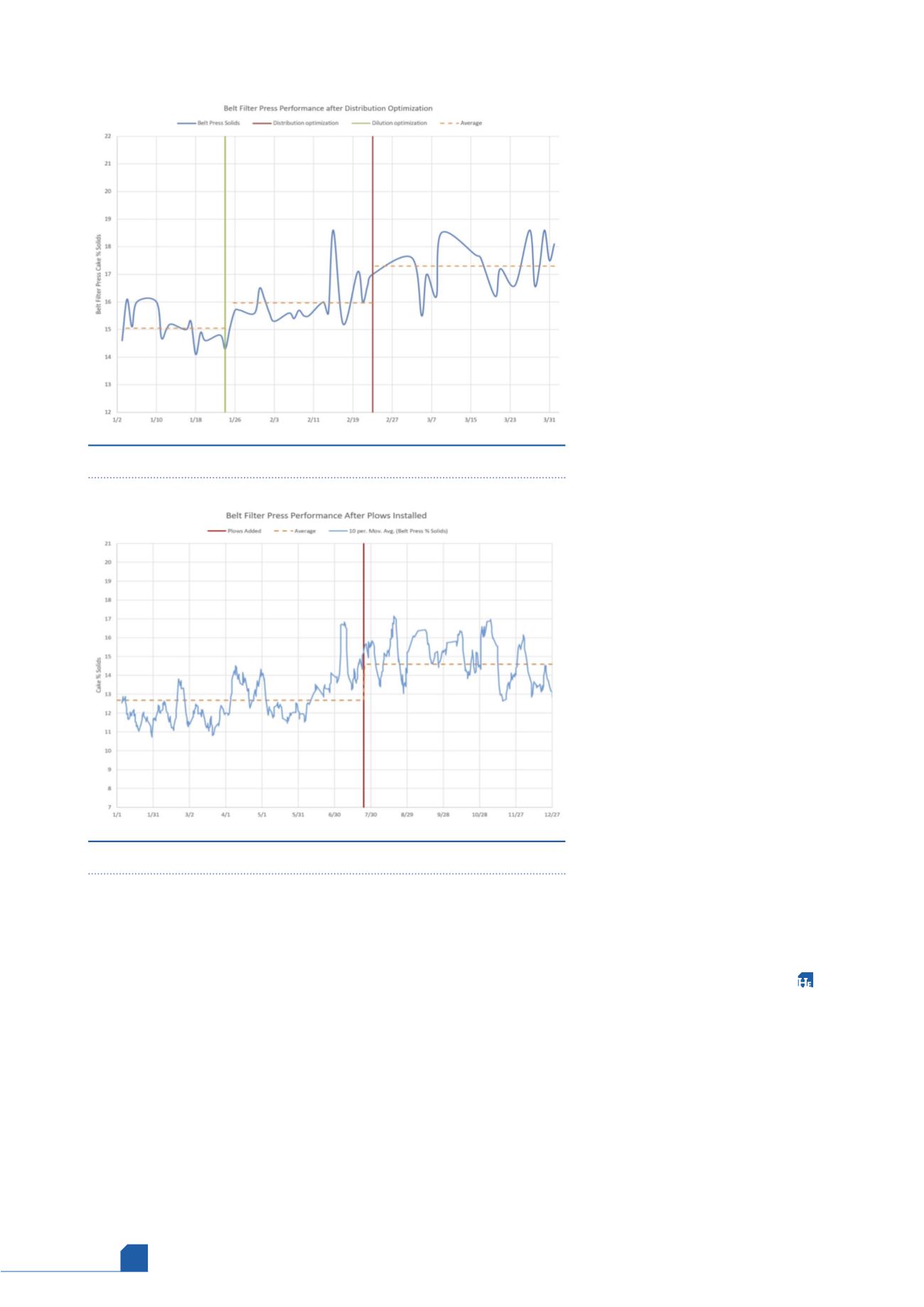
July
2020
HYDROCARBON
ENGINEERING
46
dewatering sludge to expose new sections of the belt for free
water to drain through. In addition to exposing sections of the
belt, the shifting action caused by the plows also turns the
sludge, creating a path for the free water that pooled on top
of the sludge to bypass flowing through the solids and drain
much more quickly. Modifications to the plows generally
consist of adding additional rows of plows and aligning the
plows to get maximum shifting of the solids.
Results obtained through GDS
optimisation
In two separate industrial wastewater treatment sites, the GDS
of the BFPs on site were optimised. System 1 adjusted the
distribution pipe to distribute evenly across the entirety of the
belt, as was mentioned previously, but also installed an
additional row of plows to accompany the four rows already
present. System 2 had a distribution system that evenly
distributed the solids across the entirety of
the belt, but lacked plows to assist the
drainage of free water. In this system,
temporary rows of plows were installed on
the press. In both instances, no other
changes were made to the BFP operation
and both systems experienced a 1 – 2%
increase in cake solids as soon as the
changes were made.
System 1 saw an increase in cake solids
percentage from 15.97% to 17.3%. This
resulted in a 7.7% decrease in the overall
amount of cake shipped off site for disposal
and a 9.1% decrease in lb of water shipped
off site for disposal with the sludge
(Figure 2).
At the average cost to dispose of solids
being US$40.92
5
in the region this site is
located, the optimisation of the distribution
section cut the price for disposing of 1 t of
biological solids out of the biological
treatment area and into landfill by US$19.64.
System 2 saw an increase in cake solids
percentage from 12.68% to 14.49%. This
resulted in a 12.5% decrease on the overall
amount of cake shipped off site for disposal
and a 14.3% decrease in lbs of water shipped
off site for disposal with the sludge
(Figure 3).
At the average cost to dispose of solids
being US$40.92 in the region this site is
located, the installation of the plows into
the GDS cut the price for disposing 1 t of
biological solids out of the biological
treatment area and into landfill by US$40.51.
Conclusion
Rising costs of solids disposal across the US
demand greater performance and efficiency
from the solids dewatering units in
wastewater treatment plants in order to
control costs. Inexpensive improvements
and mechanical optimisations to the GDS
result in tens of thousands of dollars in savings by improving
the overall performance of BFPs, with little to no costs after
the installation and implementation of the upgrades. These
improvements pay for themselves in a matter of months and
continue to provide benefits for years after installation.
References
1.
‘Solids Process Design and Management’, Water Environment
Federation, (2012).
2.
ANDREOLI, C. V., SPERLING, M. V., and FERNANDES, F., ‘Biological
Wastewater Treatment Series: Volume 6 Sludge Treatment and
Disposal’, (2007).
3.
TUROVSKIY, I. S. and MATHAI, P. K., ‘Wastewater Sludge Processing’,
(2006).
4.
‘Report on the management of wastewater treatment sludge
and septage in Vermont: an analysis of the current status and
alternatives tio land application’, Conservation, Agency of Natural
Resources Department of Environmental, (2015).
5.
KANTNER, D. L. and STALEY, B. F., ‘Environmental Research and
Education Foundation (2019) “Analysis of MSW Landfill Tipping Fees
- April 2019”’, (2019).
Figure 3.
Results for System 2.
Figure 2.
Results for System 1.








